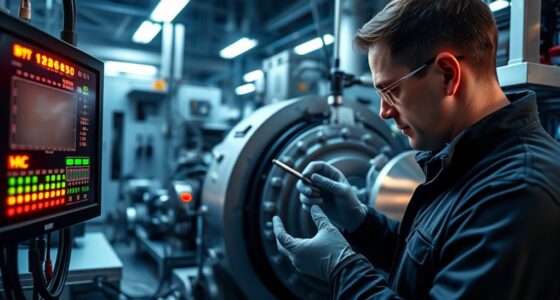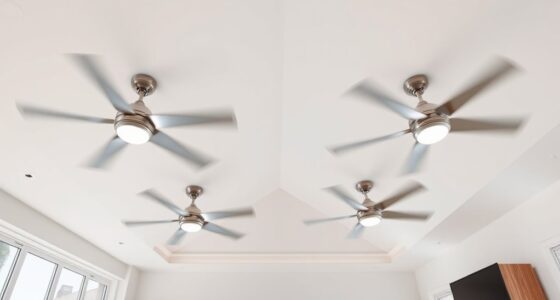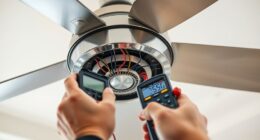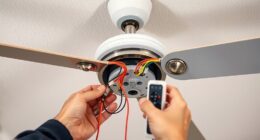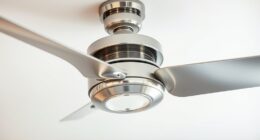In dry climates, evaporative coolers outperform ceiling fans by lowering indoor temperatures more effectively due to their water-based cooling process, which adds moisture and speeds up cooling. Ceiling fans create gentle breezes but don’t markedly lower temperatures. Evaporative coolers use less electricity and are more cost-efficient long-term, but they need regular maintenance. To optimize comfort, proper fan placement and understanding how each method works are key—keep exploring for detailed tips.
Key Takeaways
- Evaporative coolers significantly lower indoor temperatures in dry climates by adding moisture, outperforming ceiling fans in cooling efficiency.
- Ceiling fans provide gentle airflow and are quieter but do not reduce temperature or humidity levels effectively.
- Proper placement of fans enhances airflow, maximizing cooling benefits in dry environments.
- Evaporative coolers require regular maintenance and higher initial costs but are more energy-efficient long-term.
- In dry climates, evaporative coolers are generally more effective than ceiling fans for cooling and humidity control.
How Each Cooling Method Works in Dry Environments
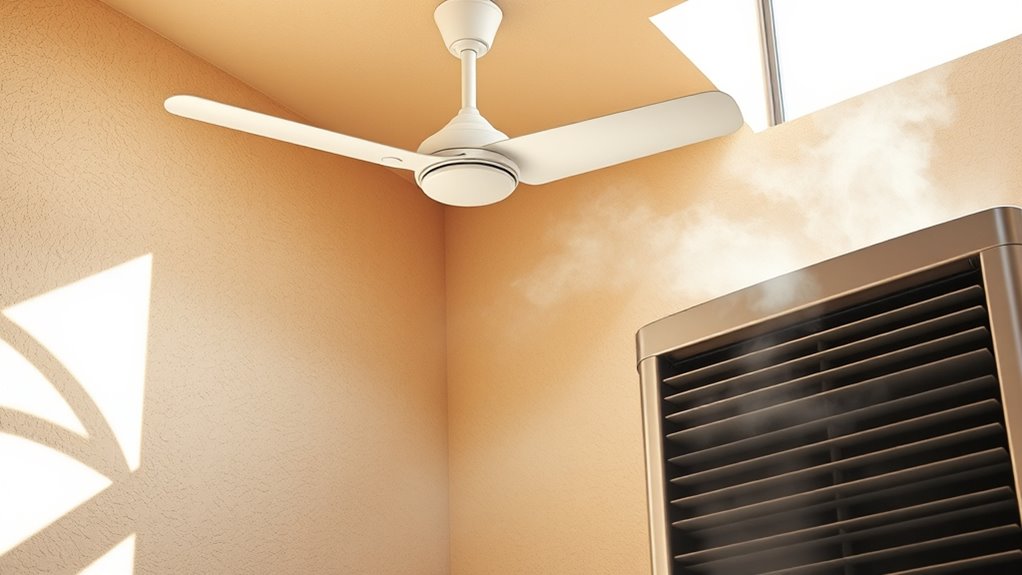
In dry environments, both ceiling fans and evaporative coolers operate differently to provide cooling. Ceiling fans circulate air, creating a wind-chill effect that makes you feel cooler without changing humidity levels. They’re easy to install and require minimal maintenance, but they don’t directly control humidity. Evaporative coolers, on the other hand, use water evaporation to lower air temperature, adding humidity to the space. This humidity control benefits dry conditions but can be problematic if humidity gets too high. Installation challenges for evaporative coolers include ensuring proper ventilation and water supply, which can be more complex than installing ceiling fans. Understanding these differences helps you choose the right cooling method suited for dry climates. Additionally, knowing how air purifier technologies can enhance indoor air quality in dry environments can be useful when optimizing overall comfort and health. To further improve the efficiency of evaporative coolers, proper ventilation strategies are essential to maintain optimal humidity levels and airflow.
Energy Efficiency and Cost Comparison
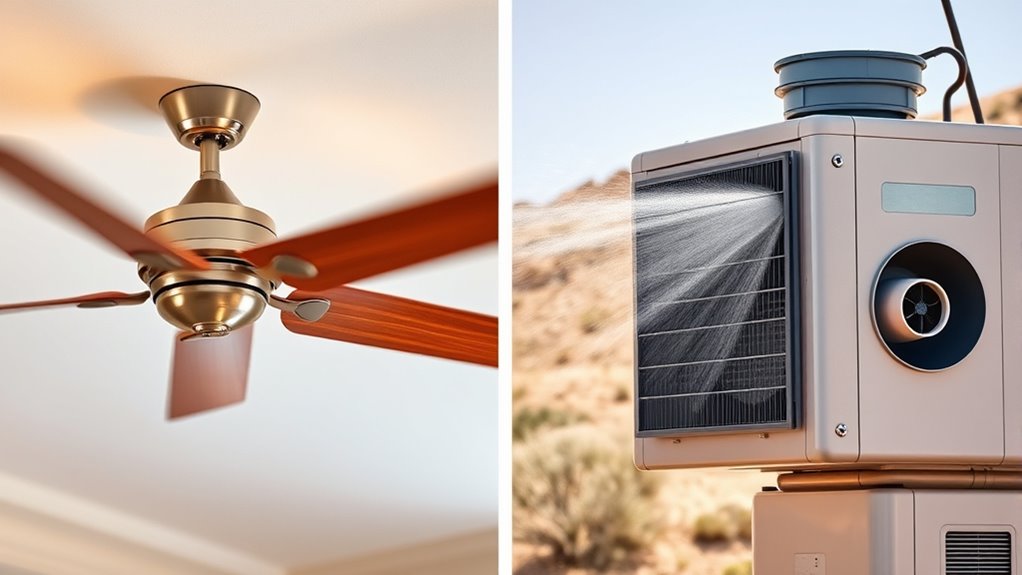
When comparing energy efficiency and costs, evaporative coolers generally use less electricity than ceiling fans, making them more economical for cooling large spaces in dry climates. They excel in humidity control, adding moisture to the air, which can reduce the need for additional humidification. Evaporative coolers typically have higher upfront costs due to installation requirements, such as water supply and proper ventilation, but their operational costs remain lower over time. Ceiling fans, on the other hand, consume less power per hour and are easier to install, making them a budget-friendly option initially. However, they don’t provide humidity control and are less effective in large or particularly dry environments. Your choice depends on balancing initial investment, ongoing costs, and the need for humidity regulation. Additionally, Hyundai Tuning techniques can optimize the efficiency of cooling systems in various vehicles and environments. Proper system maintenance can further enhance the performance and longevity of these cooling options. Incorporating climate-specific solutions can also improve overall cooling effectiveness in dry conditions.
Effectiveness in Temperature Reduction
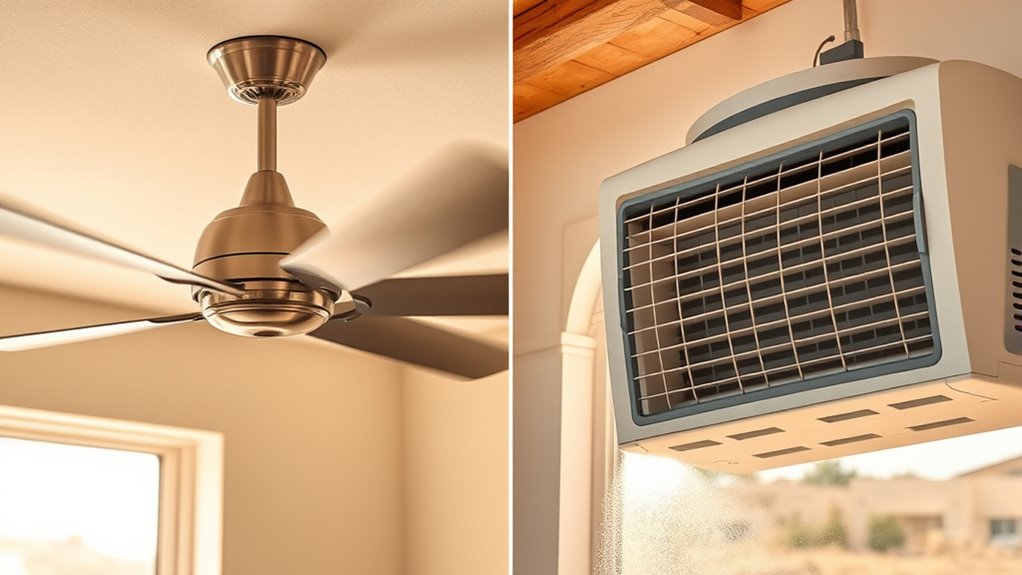
Evaporative coolers often outperform ceiling fans when it comes to lowering indoor temperatures, especially in dry climates. They reduce temperature more effectively by adding moisture to the air, which helps cool the space faster. The process of evaporation is highly effective in dry environments, making evaporative coolers particularly suitable for such conditions. Additionally, they can also improve air quality by increasing humidity levels in arid areas. However, in humid air, their effectiveness decreases because the cooling process relies on evaporation, which is less efficient with moisture already present. Noise levels can also vary; evaporative coolers tend to be louder than ceiling fans, which operate quietly. Additionally, filter replacement is essential for maintaining optimal performance of evaporative coolers. Here’s a quick comparison:
- Evaporative coolers provide greater temperature reduction in dry air.
- Humid air hampers their cooling efficiency.
- Ceiling fans produce minimal noise but don’t substantially lower temperatures.
Your choice depends on climate and noise tolerance, but for effective cooling, evaporative coolers generally lead in temperature reduction.
Comfort Levels and Air Quality
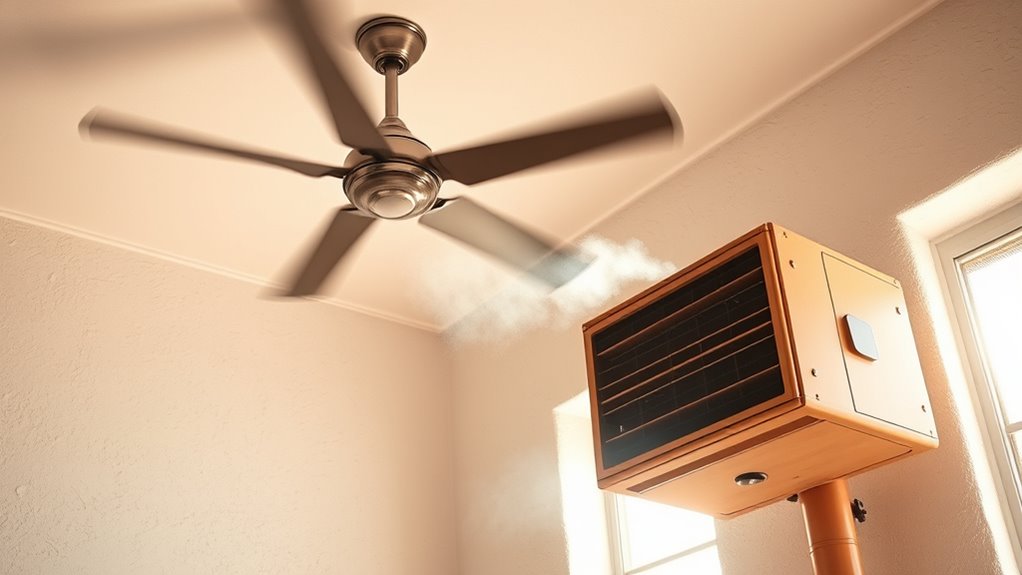
Choosing between a ceiling fan and an evaporative cooler considerably impacts your comfort and air quality. Ceiling fans provide a gentle breeze, helping you feel cooler without markedly affecting air freshness. They operate quietly, with noise levels that rarely disturb your relaxation. Their aesthetic appeal also enhances your room’s decor, blending seamlessly with various styles. Evaporative coolers, on the other hand, bring in fresh air and add humidity, which can improve comfort in dry climates. However, they might generate more noise, especially when the water pump or fan runs at higher speeds. Air quality is generally better with ceiling fans, as they don’t introduce moisture or odors. Additionally, understanding dog breeds can help you select a pet that complements your climate and living environment, enhancing your overall comfort. Proper ventilation is also essential in managing indoor air quality effectively. Overall, your choice influences how comfortable you feel and the air you breathe daily.
Maintenance and Operating Costs
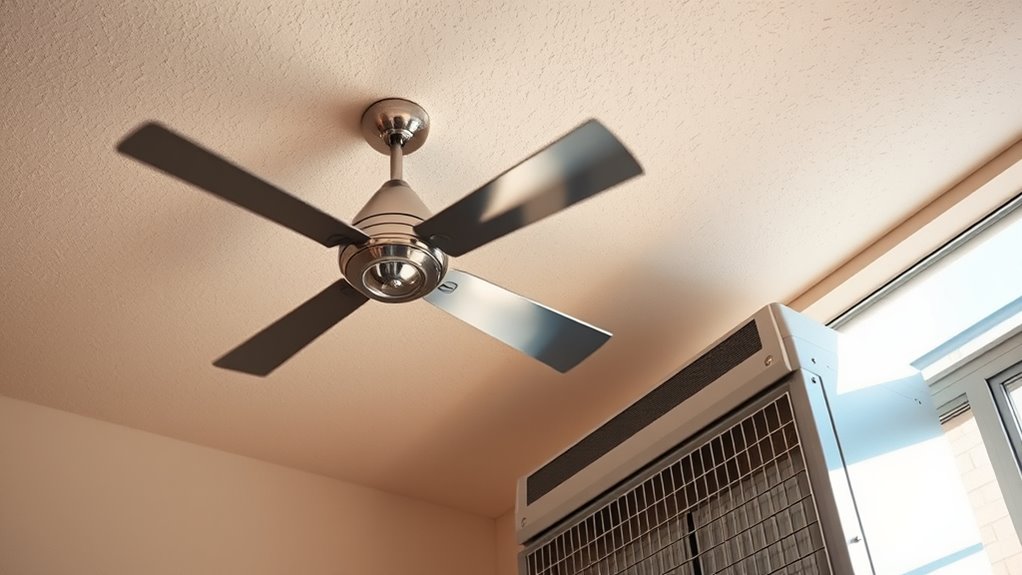
Maintenance and operating costs play a significant role in deciding between a ceiling fan and an evaporative cooler. Ceiling fans generally have lower upfront costs and minimal maintenance, primarily requiring blade cleaning and occasional motor lubrication. In contrast, evaporative coolers need regular water panel replacements, cleaning, and water supply management, which can raise expenses over time. When considering humidity control, evaporative coolers actively add moisture, potentially increasing operating costs if humidity levels are already high. Noise levels also influence costs, as ceiling fans tend to operate quietly and require less soundproofing or repairs. To summarize: 1. Ceiling fans are cost-effective with low maintenance. 2. Evaporative coolers have higher ongoing costs due to water and filter needs. 3. Noise levels impact long-term maintenance and comfort. Proper filter maintenance is essential for extending the lifespan and efficiency of evaporative coolers. Additionally, choosing energy-efficient models can further reduce long-term operating costs.
Best Practices for Maximizing Cooling Performance
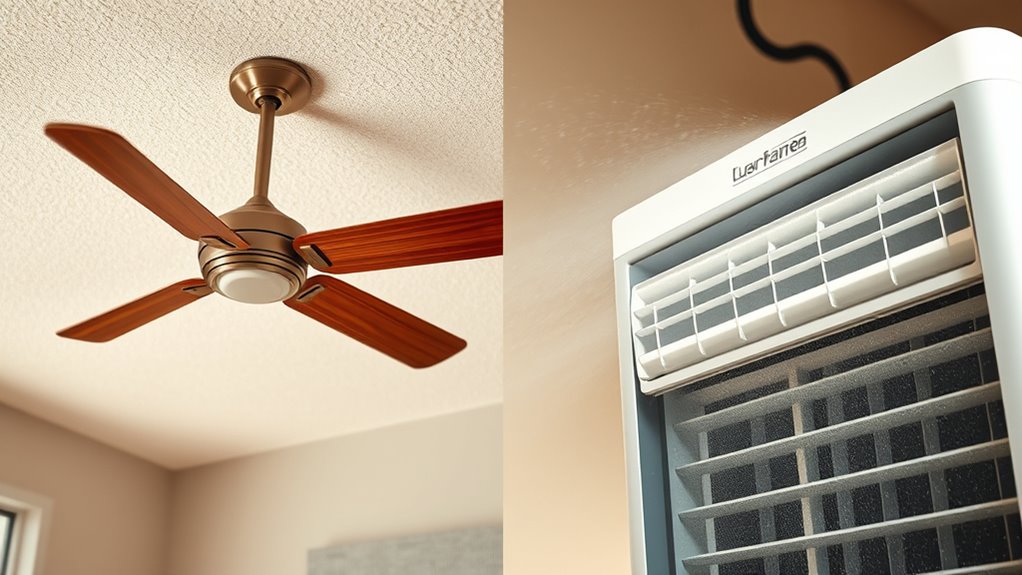
To get the most out of your cooling devices, start by optimizing fan placement to guarantee even airflow throughout the room. You should also enhance airflow circulation by using ceiling fans or strategically positioning fans to cover the entire space. These simple adjustments can make a significant difference in how effectively your cooling system cools your environment. For optimal results in dry climates, consider the benefits of evaporative coolers, which can be particularly effective when airflow is properly circulating water parks in dry regions. Additionally, choosing the right air-purifying plants can improve indoor air quality and complement your cooling efforts, much like selecting the appropriate cooling method for your environment.
Optimize Fan Placement
Maximizing your fan’s cooling performance starts with strategic placement. Proper fan positioning enhances airflow enhancement and ensures cool air circulates effectively. To achieve this, consider these best practices:
- Mount the fan high on the ceiling to promote better air circulation.
- Aim the blades or oscillation toward the center of the room, avoiding obstruction.
- Keep furniture and objects clear of airflow paths to prevent disruption.
Positioning your fan correctly prevents stagnant air pockets and distributes cool air evenly. Adjust the fan’s angle and height based on room size and layout. Remember, ideal fan placement isn’t just about location; it’s about creating a continuous, smooth airflow pattern that maximizes cooling efficiency in dry climates. Proper fan positioning directly impacts airflow enhancement and overall comfort.
Enhance Airflow Circulation
Enhancing airflow circulation is key to boosting your cooling system’s effectiveness. Proper airflow patterns ensure cool air reaches every corner, preventing hot spots. To optimize this, focus on strategic fan placement—placing fans where they can promote cross-ventilation and direct airflow efficiently. Consider the following for better circulation:
| Fan Placement | Airflow Pattern | Result |
|---|---|---|
| Near windows, facing inside | Pulls cool air in, pushes warm air out | Improved cooling, fresh air intake |
| Ceiling fans, high up | Creates circular airflow | Even temperature distribution |
| Doorway corners | Guides air across rooms | Eliminates stagnant zones |
Adjusting fan placement based on these airflow patterns maximizes cooling performance and keeps your space comfortably dry. Additionally, understanding airflow dynamics can help you fine-tune your setup for optimal results. Proper use of cookies can enhance your experience by providing tailored content and site functionality. Recognizing the importance of fuel injection cleaning can also prevent issues that reduce cooling efficiency in some systems.
Frequently Asked Questions
Which Cooling Method Is Better for Small Spaces?
For small spaces, you should consider portable options that offer energy efficiency and ease of use. Ceiling fans are great for circulating air without much energy, but evaporative coolers can provide more significant cooling in dry climates. If you prefer portability and low energy use, a portable evaporative cooler might be your best choice. It cools effectively without taking up much space and keeps energy costs down, making it ideal for small areas.
How Do Humidity Levels Affect Each Cooling Option?
Humidity levels considerably impact your cooling options. With high humidity, you’ll find that ceiling fans provide better humidity control by circulating air without adding moisture. Evaporative coolers, however, rely on moisture levels to cool effectively, making them less suitable in humid environments. In dry climates, evaporative coolers excel by adding moisture, while ceiling fans keep air moving without affecting humidity. Choose based on your local humidity conditions for ideal comfort.
Can Ceiling Fans Improve Air Quality in Dry Climates?
Did you know ceiling fans can improve air quality by promoting air circulation? In dry climates, they help disperse dust and allergens, aiding air purification. While they don’t filter air like purifiers, their continuous movement can reduce odors by preventing stagnant air. So yes, if used properly, ceiling fans can enhance indoor air quality and odor control, making your space more comfortable without relying solely on air filtration systems.
Are Evaporative Coolers Suitable for High-Altitude Areas?
You might find evaporative coolers less suitable for high-altitude areas, especially in cold climates. At high altitudes, the lower oxygen levels and cooler temperatures reduce the cooler’s effectiveness since they rely on dry air to work efficiently. Cold climates and high-altitude conditions often mean more humidity and lower temperatures, which can cause evaporative coolers to underperform or even freeze up. So, consider other cooling options better suited for such environments.
What Safety Precautions Are Necessary for Installation?
They say safety first, and that’s true when installing an evaporative cooler. You should always double-check electrical wiring to avoid shocks or fires. Confirm mounting safety by securely anchoring the unit on a stable surface, following the manufacturer’s instructions. Turn off power during installation, use proper tools, and consider hiring a professional if you’re unsure. These precautions keep your home safe and your cooler running smoothly.
Conclusion
Choosing between a ceiling fan and an evaporative cooler depends on your dry climate needs. Like two sides of the same coin, each offers unique advantages—fans circulate air for comfort, while coolers lower temperatures through evaporation. Consider your priorities: energy savings or more substantial cooling. Ultimately, the right choice transforms your space from a furnace into a revitalizing haven, proving that understanding your environment releases the secret to truly cool comfort in the desert of life.


